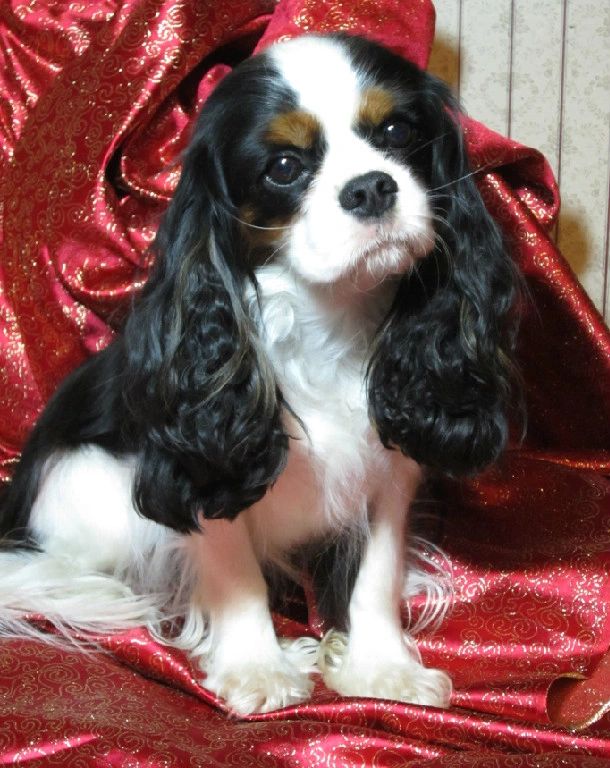About Us
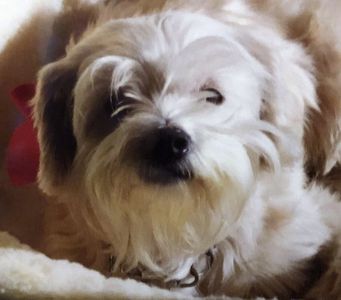
Redwood Forest Cavaliers is located on the North Coast of California. When you're driving up Highway 101 from the Bay area, once you hit Humboldt County, you see nothing but giant redwoods for miles and miles. I always say, “We have more trees than people!”
We adopted our first Cavalier a couple of years after our dog, Precious died. A tiny terrier/poodle pup we adopted from the local shelter, Precious lived with us for 14 years. My husband and I decided we would not get another dog, but eventually we realized our “empty nest” was a bit lonely.

I began researching the breeds to see if “the perfect dog” for us existed. We wanted a small dog that was smart and didn’t require a great deal of exercise. I also looked at how much they shed, bark and how aggressive they are. Since we planned to take the dog to work with us (we own the company), it would need to be “people-friendly”. And, finally, we needed to be assured that the dog would be good with children. (Note: We now have three grandsons: Leopold, born in 2009, Maxwell 2011, and Theodric 2013!)
Cavalier King Charles Spaniel was the breed we chose. I found a reputable breeder who had two female litter-mates. He considered both to have show potential. Before we had chosen which of the pups we wanted, the breeder had to move back East, and made us an offer to take both girls. We accepted, and oh, what a wonderful decision we made! I have heard from many folks that Cavaliers are like potato chips: “You can’t have just one!” My degree is in music and I studied and sang opera, so we named them Bella Donna (Italian for beautiful lady) and Bianca Donna (white lady).

Over time, we watched them mature into wonderful examples of the breed and decided to show them. We attended dog shows sponsored by the American Kennel Club (AKC.org) and the Cavalier King Charles Spaniel Club (CKCSC.org). After reading many books, attending dog shows, Cavalier shows, consulting with other breeders and our vet, we decided to become breeders of these wonderful, little dogs. Sadly Bianca died of Cushing's Disease on February 18, 2018 at the age of 12.
We strive to breed intelligent, beautiful and happy Cavalier King Charles Spaniels, paying particular attention to temperament, health, and size.
Cavaliers, a very loving and affectionate breed, have unique personalities. They are treated with love as members of our family. We keep our numbers small in order to give them the individual attention they deserve.
Our puppies are raised in our home, watch TV with us and several sleep in our bed!
Breed History

(Image: Future King Charles II, circa 1635)
Today’s Cavalier King Charles Spaniel is descended from the small Toy Spaniels depicted in so many sixteenth, seventeenth, and eighteenth century paintings. These paintings show small spaniels with flat heads, high set ears, almond eyes, and rather pointed noses. During Tudor times, Toy Spaniels were quite common as ladies' pets, but it was under the Stuarts that they were given the royal title of King Charles Spaniels.
King Charles II was seldom seen without 2 or 3 spaniels at his heels. He was so fond of his little dogs, that he wrote a decree that the King Charles Spaniel should be accepted in any public place, even in the Houses of Parliament. (This decree is still in existence today in England.) As time went by, and with the coming of the Dutch Court, Toy Spaniels went out of fashion and were replaced in popularity by the Pug. One exception was the strain of red and white Toy Spaniels that was bred at Blenheim Palace by various Dukes of Marlborough.

(Image: Future Queen Victoria with her dog, Dash - 1833)
Young Queen Victoria had beloved tri-color spaniel called "Dash". Dash features prominently in early episodes of the excellent PBS series "Victoria".
Long ago, there were no dog shows and no recognized breed standard, so both type and size varied. By the mid-nineteenth century, England took up dog breeding and dog showing seriously. Many breeds were developed and others altered. This brought a new fashion to the Toy Spaniel - dogs with the completely flat face, undershot jaw, domed skull with long, low set ears and large, round frontal eyes of the modern King Charles Spaniel (also called "Charlies" and known in the United States today as the English Toy Spaniel). As a result of this new fashion, the King Charles Spaniel, of the type seen in the early paintings, became almost extinct.
In 1926, the Kennel Club was persuaded to allow a rich American to offer prizes for the best bitch or dogs of the Blenheim variety as seen in King Charles II's reign, after he had exhausted his search throughout in England. He was looking for foundation stock to breed Toy Spaniels that resembled those in the old paintings. All he could find were the short-faced "Charlies".
The King Charles breeders did not take this challenge very seriously as they had worked hard for years to do away with the long nose. Gradually, as the big prizes came to an end, only people really interested in reviving the dogs as they once had been were left to carry on the breeding experiment. Little had been achieved after five years. The Kennel Club was of the opinion that the dogs were not sufficient in number, nor of a single type, to merit a breed registration separate from the Charlies.

(Image: Ann's Son -1928)
The final prize was awarded to Miss Mostyn Walker’s dog, “Ann’s Son”, in 1928. (Unfortunately, Mr. Eldridge died in 1928 at age 70, only a month before Crufts, so he never saw the results of his challenge prizes.) It was in the same year that a breed club was founded, and the name Cavalier King Charles Spaniel was chosen. It was very important that the association with the name King Charles Spaniel be kept as most breeders bred back to the original type by way of the long-faced throwouts from the kennels of the short-faced variety breeders. Some of the stock threw back to the long-faced variety very quickly. Pioneers were often accused of using outcrosses to other suitable breeds to get the long faces, but this was not true, and crossing to other breeds was not recommended by the club.
At the first meeting of the club, held the second day of Crufts in 1928, the standard of the breed was drawn up; it was practically the same as it is today. Ann's Son was placed on the table as the live example, and club members brought all the reproductions of pictures of the sixteenth, seventeenth, and eighteenth centuries they could muster. As this was a new and tremendous opportunity to achieve a really worthwhile breed, it was agreed that as far as possible, the Cavalier should be guarded from fashion, and there was to be no trimming. A perfectly natural dog was desired and was not to be spoiled to suit individual tastes, or as the saying goes, "carved into shape." Kennel Club recognition was still withheld, and progress was slow, but gradually people became aware that the movement toward the "old type" King Charles Spaniel had come to stay. In 1945, the Kennel Club granted separate registration and awarded Challenge Certificates to allow the Cavalier King Charles Spaniel to gain their championships.
A whimsical tale ...The Duke and Duchess of Marlborough kept Toy or Comforter Spaniels, lovingly known as “Carpet Spaniels.” It was said they were a beautiful adornment to any drawing room. While the Duke was away, fighting the Battle of Blenheim, his wife waited anxiously at home for news of her beloved. During this time, she had a comforter Spaniel on her lap constantly, pressing her thumb on the top of the little female’s head to release her tension. The bitch was in whelp and when the puppies arrived, all displayed the red thumbprint on their heads! The Blenheim spot, also called the Lozenge, is a desired trait on the little ruby and white dogs.
Our Dogs
Gershwin
Robin's Nest Rhapsody in Blue of Redforest
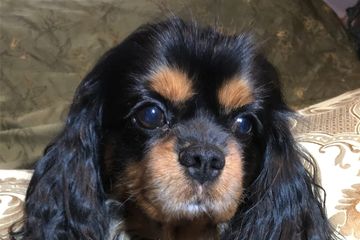

Gershwin is a vibrantly-marked black & tan. He is extremely active and must play fetch with his favorite toys every single day. Gershwin was born January 18, 2014. His sire is (Champion) Turretbank To Sir With Love and his dam is Robin's Nest Torch Song.
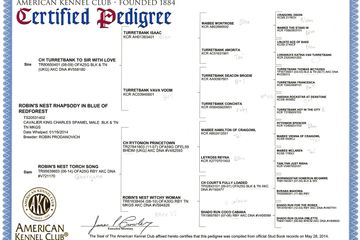
Tandie
Diva's Standing Ovation of the Redwoods


Tandie is a very pretty Blenheim. She has an independent spirit - she knows what she wants and will keep reminding us until she gets her way. Tandie was born June 29, 2012. Her sire is Legacy Huntingridge Lastat and her dam is our very own Puccini's Diva.

Dory
Redforest Secret Love


Dory is our youngest Cavalier. She is an extremely affectionate Blenheim with beautiful, big, brown eyes. She exuberantly greets us every morning by jumping on our chests to awaken us. Dory was born September 20, 2016. Her sire is (Grand Champion) Belcarra Straight Shot Remington of Bear River Ranch and her dam is our own Puccini's Diva of the Redwoods.

Alumni
Puccini
Maestro Puccini of the Redwoods


Puccini was our first male Cavalier. He is the sire of many beautiful, sweet-tempered dogs. Puccini had a natural smile on his face and loved to greet strangers on the street. We lost him to lymphoma on January 16, 2016 at the age of 9.

Penny Lane
Helmvine Penny Candy of the Redwood


Penny Lane is our beautiful Ruby Cavalier. She was born March 2, 2009. Penny is a glutton for love. Her internal clock will only allow a couple of hours between petting sessions.

Diva
Puccini's Diva of the Redwoods


Diva is a gorgeous, sweet-natured Tri-color. She was born May 31, 2010. Diva is arguably the most beautiful dog we've ever had. Diva's descendants carry on her gentle nature and physical beauty. She is from our own Melody Fair's first litter. Our own Maestro Puccini was her father.

Melody Fair
Helmvine Melody Fair of the Redwoods

Melody Fair is our first tri-color female Cavalier. She was born May 7, 2007. In her younger days, Melody loved to chase windblown leaves during our daily walks. Nowadays she prefers to chill out and lounge on the softest cushion she can find.

Bianca Donna
Mens-Am Bianca Donna of the Redwoods
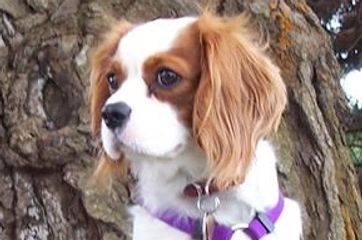

Bianca and her sister, Bella, were our first Cavaliers. Bianca was serious and smart. She had a beautiful white coat and the perfect Blenheim spot on her head. We lost Bianca to Cushing's Disease in 2018 at the age of 12.

Bella Donna
Mens-Am Bella Donna of the Redwoods

dd a description about this item

Bella is a beautiful, petite, Blenheim Cavalier. She was born in 2005 and is our oldest dog. Bella developed cataracts at the age of seven which progressed to glaucoma in her right eye. She had her right eye removed in 2016 and her left eye removed in 2019. She is still heart healthy and gets around very well despite her blindness.

Copyright © 2018 Redwood Forest Cavaliers - All Rights Reserved.
Powered by GoDaddy Website Builder
